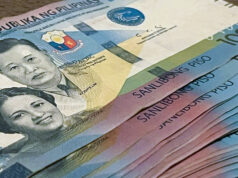Remittance increase slows in November
By Melissa Luz T. Lopez
Senior Reporter
CASH REMITTANCES increased annually for a second straight month in November last year but at a slower pace, the central bank reported yesterday, as overseas Filipino workers (OFWs) likely held on to their cash given a stronger exchange rate.
Money sent home by migrant workers totalled $2.262 billion that month, smaller than the $2.275 billion inflows recorded in October though two percent more than November 2016’s $2.217 billion, the Bangko Sentral ng Pilipinas (BSP) said.
While monthly inflows have stayed above $2 billion since February 2016, November 2017’s rise was slower than the year-ago’s 18.5% surge and October last year’s 8.4%, according to BSP data.
Remittances coursed through banks totaled $25.318 billion as of November, 4.0% more than the $24.341 billion recorded in 2016’s comparable 11 months. This growth pace matches the central bank’s forecast for the entire year, during which it expects total remittances to hit a fresh high at $28 billion.
The United States and Germany were the biggest sources of remittances in November alone.
Land-based OFWs sent 3.7% more money over the preceding year, while those working at sea wired 5.1% more than in 2016.
Sought for comment, a bank analyst said the stronger peso and easing price pressures on basic goods may have prompted overseas workers to send less money to their families in the Philippines.
“I think the slowdown in overseas Filipinos (OF) remittance growth for November was partly induced by a monthly appreciation in the Philippine peso vis-a-vis the US dollar as well as a moderation in inflationary pressures,” said Angelo B. Taningco, economist at Security Bank Corp. “[T]he stronger peso would tend to have discouraged OF remittances.”
The peso averaged P51.0384 versus the dollar in November, posting a slight recovery from the previous month’s P51.3433 as it traded at the P50 level against the greenback. The local currency touched fresh 11-year-lows in October as the peso traded above the P51 level against the greenback. A stronger peso-dollar rate meant that foreign currencies sent by OFWs are worth less once converted to pesos.
Domestic inflation also eased to 3.3% in November from October’s three-year peak of 3.5%, reflecting moderate overall price increases.
Mr. Taningco said remittance growth likely remained “modest” in December, as inflation steadied while the peso traded around the P49:$1 mark.
“With this, I believe OF remittances’ contribution to household consumption and economic growth during the fourth quarter of last year may have been modest also,” the bank economist added.
Remittances support domestic consumption, which in turn spurs overall economic growth. The Philippine economy expanded by 6.9% in the third quarter, pulling the nine-month climb to 6.7% against the government’s 6.5-7.5% full-year target for 2017.




